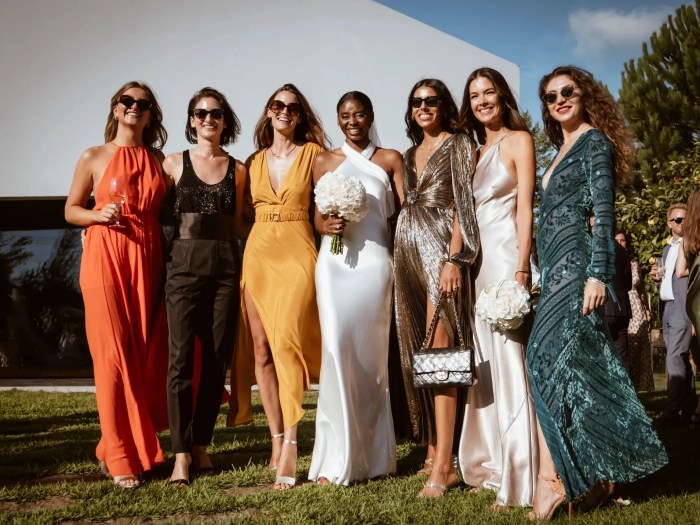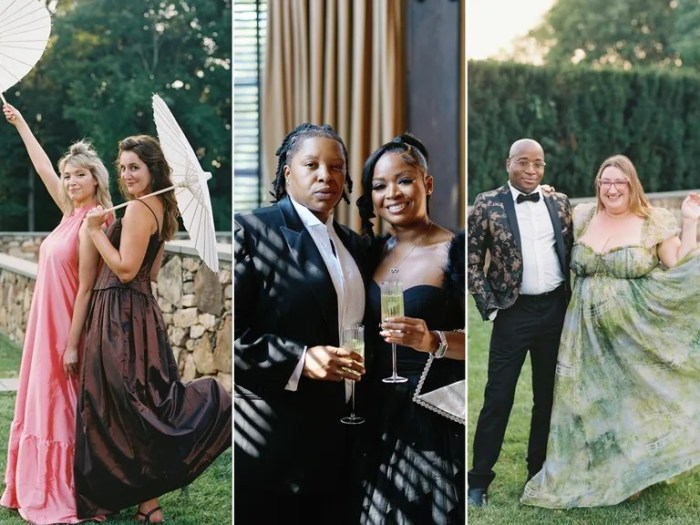Wedding Guest Attire

Source: vogue.com
How to dress wedding – Choosing the right attire as a wedding guest is crucial for showing respect to the couple and blending seamlessly with the event’s atmosphere. The appropriateness of your outfit depends heavily on the wedding’s formality, the season, and the venue.
Choosing the right attire for a wedding depends heavily on the venue and dress code. For a beach wedding, a breezy and elegant style is often preferred, and a great option to consider are stunning halter beach wedding dresses , which offer both comfort and sophistication. Ultimately, selecting an outfit that aligns with the overall wedding atmosphere ensures you’re appropriately dressed for the celebration.
Appropriate Attire for Various Wedding Styles
Wedding formality dictates the level of dress. Formal weddings typically call for floor-length gowns or elegant suits. Semi-formal events allow for cocktail dresses or dressy separates. Casual weddings offer more flexibility, with options ranging from knee-length dresses to stylish pantsuits.
Outfit Examples for Different Seasons
Seasonal considerations are key. Spring weddings might see pastel-colored dresses or floral prints. Summer weddings often feature lighter fabrics like linen or cotton. Fall weddings lend themselves to richer colors and textures like velvet or lace. Winter weddings often call for warmer fabrics and darker, richer colors.
Choosing Wedding-Appropriate Colors and Patterns
Avoid wearing white or anything too similar to the bride’s dress. Bright, bold colors can be appropriate for casual weddings, while more subdued tones are suitable for formal affairs. Subtle patterns are generally preferred over loud or distracting ones.
Outfit Choices for Different Wedding Venues
| Venue | Women’s Attire | Men’s Attire | Considerations |
|---|---|---|---|
| Church | Knee-length or floor-length dress; elegant pantsuit | Suit or tuxedo | More formal attire is generally expected. |
| Beach | Flowing maxi dress; sundress; jumpsuit | Linen suit; light-colored shirt and pants | Comfortable, breathable fabrics are essential. Consider footwear suitable for sand. |
| Garden | Midi dress; floral print dress; jumpsuit | Suit; button-down shirt and chinos | Elegant yet comfortable attire is ideal. Consider the terrain and potential for uneven ground. |
| Barn/Rustic | Flowing midi dress; boots; comfortable flats | Suit or sport coat; jeans | Balance elegance with practicality, given the setting’s casual feel. |
Wedding Dress Styles
Selecting a wedding dress involves careful consideration of various factors, including neckline, silhouette, fabric, and length. The perfect dress should flatter the bride’s body type and reflect her personal style.
Different Necklines and Their Suitability
Various necklines offer diverse effects. Sweetheart necklines are romantic and flattering on most body types. Halter necklines are ideal for showing off shoulders and are particularly suitable for those with a slender frame. V-necklines elongate the torso and are generally versatile.
Wedding Dress Silhouettes
Silhouettes significantly impact the overall look. A-line dresses are universally flattering, while ballgowns create a dramatic, princess-like effect. Mermaid silhouettes accentuate curves and are suitable for brides who want to showcase their figure.
Common Wedding Dress Fabrics
Fabric choice impacts the dress’s drape, texture, and overall feel. Satin is luxurious and smooth, while lace adds intricate detail and a touch of romance. Chiffon is lightweight and airy, perfect for warmer climates.
Pros and Cons of Different Dress Lengths
- Floor-length: Pros: Classic, elegant; Cons: Can be cumbersome.
- Tea-length: Pros: Flattering, versatile; Cons: Might not be suitable for all venues.
- Knee-length: Pros: Modern, comfortable; Cons: Might be considered too casual for some weddings.
Accessorizing for a Wedding
Accessories play a vital role in completing a wedding look, adding personality and enhancing the overall aesthetic. Careful selection of jewelry, hairstyle, shoes, and handbag can elevate an outfit from simple to stunning.
Choosing the Right Jewelry
Jewelry should complement the outfit and not overpower it. Delicate necklaces and earrings are suitable for most occasions, while statement pieces might be appropriate for more formal events. Avoid wearing anything too flashy or distracting.
Suitable Hairstyles
Hairstyles should complement the dress and wedding theme. An updo is elegant for formal weddings, while loose curls or a braid might suit a more casual affair. Consider the venue and weather when choosing a hairstyle.
Selecting Appropriate Shoes and Handbags
Shoes should be comfortable and stylish. Heels are generally preferred for formal events, but flats or wedges are acceptable for less formal occasions. The handbag should be small and elegant, matching the overall aesthetic.
A Complete Wedding Guest Outfit
Imagine a navy blue midi dress with delicate floral embroidery, paired with nude-colored heels and a small clutch. Delicate gold jewelry completes the look. The hair is styled in soft waves, adding a touch of romance.
A key style choice is to ensure the accessories complement, not compete with, the dress. Subtlety is key.
Groom’s Attire: How To Dress Wedding
The groom’s attire significantly contributes to the wedding’s overall aesthetic. The choice of suit, color, and fit should reflect the wedding’s formality and the groom’s personal style.
Options for Groom’s Suits
A tuxedo is the most formal option, while a suit offers a more versatile choice. Casual attire, such as a blazer and chinos, might be appropriate for very informal weddings.
Choosing the Right Color and Fit
The suit’s color should complement the wedding’s theme and the bridesmaids’ dresses. A classic navy or charcoal gray suit is always a safe bet. The fit is crucial; the suit should be tailored to flatter the groom’s physique.
Coordinating the Groom’s Attire with the Wedding Party
The groom’s attire should coordinate with the wedding party’s attire, creating a cohesive and visually appealing look. The groomsmen’s suits should complement the groom’s suit, perhaps in a similar color or fabric.
Comparison of Different Types of Men’s Formal Wear
| Type | Formality | Typical Components | Suitable Occasions |
|---|---|---|---|
| Tuxedo | Most Formal | Dinner jacket, bow tie, formal trousers | Black-tie events, formal weddings |
| Suit | Formal | Jacket, trousers, tie | Semi-formal weddings, business events |
| Sport Coat | Semi-Formal | Sport coat, dress pants, tie or open-collar shirt | Casual weddings, social gatherings |
Wedding Party Attire

Source: xogrp.com
The attire of the bridesmaids and groomsmen significantly contributes to the overall wedding aesthetic. Careful coordination ensures a visually pleasing and harmonious look.
Role of Bridesmaids and Groomsmen
Bridesmaids and groomsmen play a vital role in supporting the couple and enhancing the wedding’s visual appeal. Their attire should complement the wedding theme and the bride and groom’s style.
Coordinating Attire for Bridesmaids and Groomsmen
Bridesmaids’ dresses should complement the wedding’s color scheme and style. Groomsmen’s suits or tuxedos should coordinate with the bridesmaids’ dresses and the groom’s attire. A cohesive color palette and style create a unified look.
Selecting Colors and Styles
Color selection should consider the wedding theme, venue, and season. Styles should be chosen to flatter the bridesmaids and groomsmen’s figures and reflect the overall wedding aesthetic.
A Cohesive Wedding Party Look, How to dress wedding
Imagine bridesmaids in elegant, floor-length gowns in a dusty rose color, paired with delicate silver jewelry. Groomsmen in navy blue suits with rose-colored boutonnieres complete the look, creating a cohesive and romantic feel.
FAQ Resource
What if the invitation doesn’t specify a dress code?
If unsure, it’s always best to err on the side of slightly more formal attire. Contact the couple or a close friend for guidance.
Can I wear white to a wedding?
Generally, avoid wearing white to avoid overshadowing the bride. Off-white, ivory, or cream shades are usually acceptable.
What should I do if my outfit gets damaged before the wedding?
Have a backup outfit ready. Consider having a simple, versatile piece that can be easily dressed up or down.
How far in advance should I buy my outfit?
It’s recommended to start shopping 2-3 months before the wedding to allow time for alterations or finding a suitable alternative.
